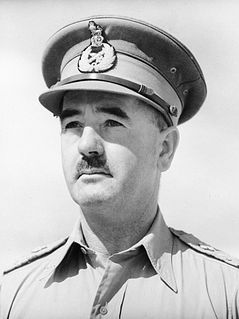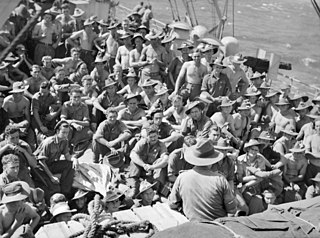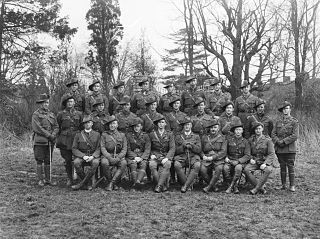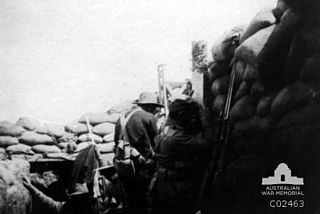
Lieutenant General Sir Leslie James Morshead, was an Australian soldier, teacher, businessman, and farmer, whose military career spanned both world wars. During the Second World War, he led the Australian and British troops at the Siege of Tobruk (1941) and at the Second Battle of El Alamein, achieving decisive victories over Erwin Rommel's Afrika Korps. A strict and demanding officer, his soldiers nicknamed him "Ming the Merciless", later simply "Ming", after the villain in the Flash Gordon comics.

Henry Arthur Goddard, was an Australian Army colonel and temporary brigadier general in the First World War.

The 36th Battalion was an infantry battalion of the Australian Army. It was originally raised in 1916 as part of the First Australian Imperial Force during World War I. Throughout World War I the battalion served on the Western Front as part of the 9th Brigade, attached to the 3rd Division. Due to heavy casualties amongst the AIF and a decrease in the number of replacements arriving from Australia in 1918, the battalion was disbanded before the war ended in order to reinforce other units in France. The 36th Battalion was re-raised in 1921 as part of the Militia based in Sydney. During World War II the battalion was attached to the 14th Brigade and was initially used in a defensive role as a garrison unit in Australia before being sent to New Guinea in 1942. Throughout the course of the war in the Pacific, the 36th Battalion spent most of the 1942–45 period overseas in New Guinea and New Britain where they undertook operations against the Japanese. In June 1945 they were returned to Australia and shortly afterwards the battalion was disbanded.

The 39th Battalion was an infantry unit of the Australian Army. It was originally raised in February 1916 for service during World War I as part of First Australian Imperial Force, with personnel being drawn mainly from the state of Victoria. Making up part of the 10th Brigade, it was attached to the 3rd Division and served on the Western Front in France and Belgium before being disbanded in March 1919. Following the re-organisation of the Australian Army in 1921, the battalion was raised again in Victoria as a unit of the Citizens Force, becoming known as the "Hawthorn–Kew Regiment". In 1937, it was amalgamated with the 37th Battalion to become the 37th/39th Battalion. Later, in August 1939 it was delinked with the 37th and amalgamated with the 24th Battalion to form the 24th/39th Battalion, before being raised again as a single unit in October 1941.

The 2nd Battalion was an infantry battalion of the Australian Army. It was initially raised for service during the First World War as part the Australian Imperial Force and saw action at Gallipoli before being sent to the Western Front in mid-1916, where it spent the next two-and-a-half years taking part in the fighting in the trenches of France and Belgium. Following the conclusion of hostilities, the battalion was disbanded in early 1919 as part of the demobilisation process.

The 9th Brigade is a Reserve formation of the Australian Army headquartered at Keswick Barracks in Keswick, South Australia, with elements located in Tasmania, New South Wales and South Australia. The brigade was first raised in 1912 in New South Wales following the introduction of the compulsory training scheme.

The 35th Battalion was an infantry battalion of the Australian Army. Originally raised in late 1915 for service during the First World War, the battalion saw service on the Western Front in France and Belgium before being disbanded in 1919. In 1921, it was re-raised in the Newcastle region of New South Wales as a unit of the Citizens Force. It was subsequently amalgamated a number of times during the inter-war years following the Great Depression, firstly with the 33rd Battalion and then the 2nd Battalion, before being re-raised in its own right upon the outbreak of the Second World War. Following this the battalion undertook garrison duties in Australia before being deployed to New Guinea where they took part in the Huon Peninsula campaign. After the end of the war, the 35th Battalion was disbanded in early 1946.

The 14th Battalion was an infantry battalion of the Australian Army. Originally raised in 1914 as part of the Australian Imperial Force for service in World War I, the battalion served at Gallipoli initially before being sent to France where it served in the trenches along the Western Front until the end of the war, when it was disbanded. It was raised again in 1921 as a part-time unit of the Citizen Forces based in Victoria. Later, during World War II the battalion was called up for defensive duties to guard against possible Japanese invasion, but in late 1942 it was merged with the 32nd Battalion to become the 14th/32nd Battalion.

The 23rd Battalion was an infantry battalion of the Australian Army. It was raised in 1915 as part of the Australian Imperial Force for service during World War I and formed part of the 6th Brigade, attached to the 2nd Division. After being formed in Australia, the battalion was sent to Egypt to complete its training, before being committed to the Gallipoli Campaign as reinforcements in September 1915. They remained on the peninsula until the evacuation of Allied troops in December, when they were withdrawn back to Egypt where they were reorganised before being transferred to the Western Front in March 1916. Over the course of the next two-and-a-half years, the 23rd took part in a number of significant battles in France and Belgium, before being disbanded in mid-1919 following the conclusion of hostilities. In 1921, the battalion was re-raised as a part-time unit within the Citizens Forces in the state of Victoria, but was amalgamated with the 21st Battalion in 1929 to form the 23rd/21st Battalion.

The 60th Battalion was an infantry battalion of the Australian Army. It was raised for service during World War I in 1916 and took part in the fighting on the Western Front for two-and-a-half years. Following the end of the war it was disbanded before being re-raised in 1921 as a part-time unit of the Citizen Force. In 1930, as a result of manpower shortages, the 60th was amalgamated with the 57th Battalion to form the 57th/60th Battalion and this unit subsequently saw service in the South West Pacific during World War II fighting against the Japanese, before being disbanded in 1946.

The 58th Battalion was an infantry battalion of the Australian Army. It was raised in 1916 for overseas service during World War I and saw action on the Western Front from June 1916 until the end of the war. Following the end of hostilities it was disbanded in 1919; however, in 1921 the battalion was re-raised as part of the part-time Citizens Force and remained in existence until 1942 when it was amalgamated with the 59th Battalion to form the 58th/59th Battalion. That battalion subsequently saw active service in the Pacific against the Japanese during World War II before being disbanded in 1946. After the war, the battalion was re-formed as an amalgamated Citizens Military Force unit, the 58th/32nd Battalion, which was based in Melbourne. This unit remained in existence until 1960 when it was subsumed into the Royal Victoria Regiment.

The 21st Battalion was an infantry battalion of the Australian Army. It was raised in 1915 as part of the First Australian Imperial Force for service during World War I and formed part of the 6th Brigade, attached to the 2nd Division. It fought during the Gallipoli campaign and on the Western Front before being disbanded in late 1918. The battalion was the first Australian battalion to commence active operations on the Western Front and also had the distinction of being the last to pull back when the Australian Corps was withdrawn from the line. In 1921, the battalion was re-raised as a part-time unit of the Citizens Force but was later amalgamated with the 23rd Battalion in 1929 to form the 23rd/21st Battalion.

The 56th Battalion was an infantry battalion of the Australian Army. It was originally raised in 1916 for service during the World War I and took part in the fighting in the trenches of the Western Front in France and Belgium before being amalgamated with the 54th Battalion in late 1918 following the German spring offensive reduced the numbers in both battalions. After the war, the battalion was re-raised as a part-time unit in New South Wales. During World War II the battalion was mobilised and undertook garrison duties in Australia until it was disbanded in 1944. It was briefly re-raised in 1956, but was disbanded the following year and its personnel used to re-raise the 4th Battalion, which later became part of the Royal New South Wales Regiment.

The 37th Battalion was an infantry battalion of the Australian Army. It was originally raised in 1916 for service during the World War I and took part in the fighting in the trenches of the Western Front in France and Belgium and was disbanded in 1918. In 1921, the battalion was re-raised as part of the part-time Citizens Forces, although it was later amalgamated with the 52nd Battalion in 1930 due to manpower shortages. In 1937, the battalion was briefly re-raised in its own right before being amalgamated with the 39th Battalion. It later returned to the order of battle in its own right as the Australian military was expanded due to concerns of a future war in Europe. Following the outbreak of World War II, the 37th Battalion served in a garrison role until 1942 when it was once again amalgamated with the 52nd Battalion.

The 22nd Battalion was an infantry battalion of the Australian Army. It was raised in 1915 as part of the Australian Imperial Force for service during World War I and formed part of the 6th Brigade, attached to the 2nd Division. It fought during the Gallipoli campaign and on the Western Front before being disbanded in 1919. In 1921, it was re-raised as a part-time unit and was merged with the 29th Battalion in 1930 to form the "29th/22nd Infantry Battalion". Split in August 1939 and known as the "22nd Battalion ", the battalion saw action against the Japanese during World War II in the Huon Peninsula and New Britain campaigns. The battalion was disbanded in June 1946. It was re-established as part of the Royal Victoria Regiment in the mid-1960s as a remote area battalion within the Citizens Military Force, and later became a part of the 8th/7th Battalion, Royal Victoria Regiment.

The 38th Battalion was an infantry battalion of the Australian Army. Originally formed in 1916 for service overseas during World War I as part of the Australian Imperial Force (AIF), the battalion was recruited from the state of Victoria and formed part of the 10th Brigade, 3rd Division. It served throughout the war on the Western Front before being disbanded in 1919. During the inter-war years, the battalion was re-raised as a part-time military unit and during the World War II undertook garrison duties in Australia, but did not see combat. After the war, it was re-formed in Victoria and was eventually subsumed into the Royal Victoria Regiment, with its honours and traditions being preserved by the 8th/7th Battalion, Royal Victoria Regiment.
The 43rd Battalion was an Australian Army infantry unit that was originally formed during the First World War as part of the all-volunteer Australian Imperial Force. Raised in early 1916, the battalion subsequently fought in the trenches of the Western Front from late 1916 until the end of the war in November 1918. After the war, the 43rd was re-raised as a part-time unit in South Australia, serving until 1930 when it was merged with the 48th Battalion. During the Second World War, the 43rd was briefly re-raised between 1942 and 1944, but did not see action before it was disbanded. After the war, the 43rd and 48th were once again merged, existing until 1960 when they became part of the Royal South Australia Regiment.

The 44th Battalion was an infantry unit of the Australian Army. Originally formed in 1916 for overseas service during World War I, the battalion fought in the trenches along the Western Front in France and Belgium between late 1916 and 1918, before disbanding at the conclusion of hostilities. During the inter-war years, the 44th became part of the part-time Citizens Force, based in Western Australia. During World War II, it undertook garrison duties in Australia but was not deployed overseas to fight. In the post-World War II period the 44th was amalgamated with the 11th Battalion, before being subsumed into the Royal Western Australia Regiment in 1960.

The 3rd Pioneer Battalion was an Australian infantry and light engineer unit raised for service during the First World War as part of the all volunteer Australian Imperial Force (AIF). Formed in Victoria in March 1916, the battalion subsequently undertook further training in the United Kingdom before arriving in France in late 1916. It later served on the Western Front in France and Belgium until the end of the war. Assigned to the 3rd Division, the 3rd Pioneer Battalion fought in most of the major battles that the AIF participated in between mid-1916 and the end of the war in November 1918. It was subsequently disbanded in early 1919.

The 4th Machine Gun Battalion was an infantry support unit of the Australian Army. Originally formed in March 1918 for service during World War I as part of the all volunteer Australian Imperial Force, it was one of five such units raised as part of the AIF during the war. The battalion consisted of four machine gun companies, which had previously existed as independent companies assigned mainly at brigade level. The battalion took part in the final stages of the war, seeing action during the Allied defensive operations during the German spring offensive and then the Allied Hundred Days Offensive, which finally brought an end to the war. The battalion was disbanded in mid-1919 during the demobilisation of the AIF following the conclusion of hostilities.




















